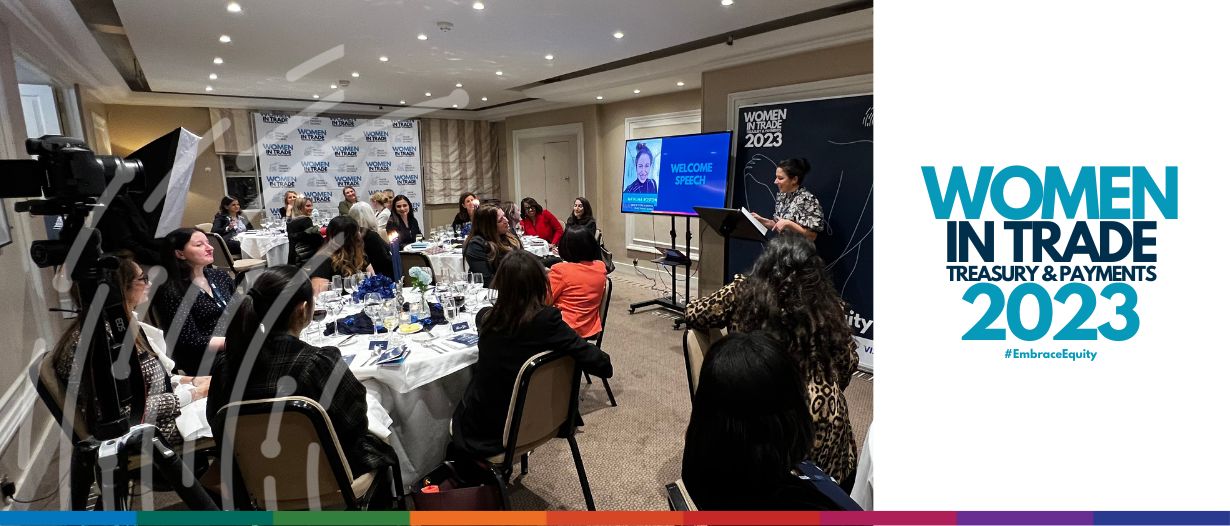“Achieving gender equality requires the engagement of women and men, girls and boys. It is everyone’s responsibility.”
Ban Ki-moon, Former Secretary-General of the United Nations
Trade Finance Global (TFG) is happy to champion International Women’s Day 2023, highlighting the stories and success of women across the trade, treasury and payments (TTP) industry and beyond.
While promoting these women and their stories is the first step, the ultimate goal is to change the underlying structures of the industry to reach gender parity.
Reaching this goal is attainable but requires a collective effort from all parties involved.
Women supporting other women is vital to achieving gender equity, but this dynamic has always existed.
The next step is finding a way for men to get involved and champion the march to gender parity.
TFG gathered women leaders to discuss their experiences and strategies to get men more involved in promoting women in trade, treasury and payments.
Setting the tone – the role of culture in promoting gender diversity
According to a Deloitte study, men held 81% of C-suite positions and 95% of CEO positions globally in the financial services industry in 2021. While the ultimate goal is to increase the number of women in these positions, change has to stem from these male leaders.
Many roundtable attendees agreed they could sense the equitable nature and overall company culture from the first interview.
One participant said, “you just get a sense of this stuff.”
One roundtable attendee said the company culture was immediately apparent when she asked for a flexible working arrangement.
The male executives supported her, “There was no awkward silence. There was no; we’ll have to discuss that. We’ll think about that later. Instead, it was, this can work for us. We can make it work.”
This type of inclusive culture ultimately pays dividends for the company.
The roundtable participants agreed that leaders who support women employees and create a genuinely equitable workplace see a rise in loyalty and productivity in response.
Male leaders must step up and “exhibit equitable and inclusive behaviour and are not ashamed of it, [I] think then it speaks volumes and spreads further around the organisation.”
Not all women face the same challenges
For far too long, the conversation has only revolved around women in developed countries who face the challenge of balancing motherhood and a career.
But this excludes many women from different backgrounds.
Research is limited in developing countries, but in the U.S. and U.K., 44% and 37% of women surveyed said they don’t want children (figure 1).
Figure 1. Share of non parents younger than 50 who say they are not likely to have childen is up from 2018. Source: Pew Research Center.
How do we support women from different backgrounds with other needs?
One participant said, “We need to start by at least identifying the key challenges that many women face and have embedded policies that support them, and then we can respond to differing needs.”
Embedded policies providing a framework for women to feel comfortable are essential for workplace equity.
Creating an open and transparent company culture can solve many of these issues.
One person said that creating this transparent environment can help normalise women’s struggles, “I would love to see an environment where I can say, I can’t come in today. I’ve just started my menstrual cycle, and it’s incredibly painful. I’m really sorry; I have to work from home.”
But not all women face the same challenges.
A participant asked, “Why can’t I just say I need a half-day?”
Some women often need to disclose why they must take time off work, putting them in uncomfortable situations – this reinforces the fact that one policy cannot fit all.
The TTP industry needs to adapt accordingly.
It’s not just a problem for mothers; it’s an everyone problem
“I have a recently divorced person in my team who has custody of his children. He needed to come to me and say, ‘How will we organise my team? I need to be at home during the afternoon because I need to pick them up from school. I need to be with them. If I don’t do that, they will take custody away from me.’ This is a problem that everyone faces.”
Mothers and fathers face familial stresses in the workplace, but real inclusivity means understanding the problems of employees without children, partners, or LGBTQ employees.
These people will face different challenges in the workplace and require other solutions. The key to making equitable progress for everyone?
“You have to speak up. Luckily, we have more women in leadership positions. As more women reach the top, they highlight these issues to the board and executives. They’re talking with men about discrimination, about parental leave.”
Male mentorship: Unconscious exclusion
“The majority of men that I work with have no ill intent. They don’t think they discriminate; they think they’re inclusive.”
But the problem lies within the unconscious behaviour of male executives.
The roundtable agreed that mentoring is one of the most effective ways to help younger employees.
However, often, male executives offer out-of-work mentoring through pub nights or sporting events. “Suddenly, they want just to be boys, and then I have to try and recreate that relationship.”
When the participant mentioned this issue, the executive immediately regretted the environment they created. Providing the proper feedback is important, but men must be aware of the culture they are building and spreading.
“She got promoted because she’s a woman”
As more women are hired and promoted internally, this phrase is said far too often.
But the data doesn’t back this statement.
More qualified women than ever are in the workplace, which will naturally lead to a higher proportion of promotions.
For example, “Rwanda had 30% quotas for electing female members of Parliament. Over the years, the quota was removed. Now they elect 56% of women anyway because then they see that women are doing an amazing job and how diversity makes a difference.”
Time and time again, women aren’t hired or elected because they are a woman; they are hired or elected because they are qualified.
However, some men still feel increasingly insecure and challenged by growing diversity.
One roundtable participant said, “The numbers don’t give them any reason to feel that way. That’s the basic starting point. Just remind them of a few statistics, and you’ll find that their case does not work.”
Don’t just talk about equity. Do it.
One of the more complex challenges is finding ways to hold companies accountable for their diversity, equity and inclusion (DEI) initiatives.
More so, there needs to be a system to ensure DEI initiatives are not box-checking exercises, filling a role with a woman just to hit a specific benchmark.
One participant said it is essential to clarify, “A company should strive to find X% of women to fill certain roles, but they must facilitate for those women to be skilled and be the right women, rather than just doing it because they’re female.”
Importantly, these targets must have financial and non-financial metrics. Companies and executives should “feel the pain if they don’t push the strategies that support that objective.”
Companies have publicly spoken about DEI policies, but things won’t change until they feel the financial or social pressure to implement them.
Every man has to engage
Gender equity has certainly made improvements in the past few decades. But there is a long way to go still. Sometimes, it feels like women take two steps forward and one step back in the workplace.
One participant said, “I find that the agenda on diversity shifts depending on leadership, then that person moves on…there is no consistency in the effort.”
All men, from entry-level positions to executives, must actively engage with each other and their female colleagues.
The change will not happen if we rely on a few inspirational leaders; it needs to be a groundswell of support.
































